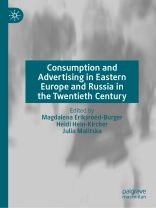This book explores Eastern European consumer cultures in the twentieth century, taking a comparative perspective and conceptualizing the peculiarities of consumption in the region. Contributions cover lifestyles and marketing strategies in imperial contexts in the late nineteenth and early twentieth centuries; urban consumer cultures in the Interwar Period; and consumer and advertising cultures in the Soviet Union and its satellite republics. It traces the development of marketing throughout the century, and the changes in society brought about by democratization and the ‘Americanization’ of consumption. Taken together, the essays gathered here make a valuable contribution to our understanding of consumption and advertising in the region.
Inhoudsopgave
Part I: Introduction. Chapter 1: Consuming and Advertising in Eastern Europe and Russia in the Twentieth Century. Introductory Remarks.- Part II: Rise of Modern Consumption and Advertising before World War II.- Chapter 2: Handmade by Peasants for Metropolitan Consumers. Textiles, Social Entrepreneurship and the Austro-Hungarian Countryside.- Chapter 3: German Advertisements in the Late Russian Empire as a Reflection of Consumer Policies, Culture, and Communication.- Chapter 4: The Role(s) of the Czechoslovak New Woman as a Consumer. The Case of the Women‘s Magazine Eva (1928-1938).- Part III: ‘Soviet Style” of Advertising and Consumption.- Chapter 5: Fur Trade in Turmoil. Pelt Commodification in Leipzig from Fin de Siècle to Sovietization.- Chapter 6: Early Soviet Consumption as a First “Battle” on the Cultural Front.- Chapter 7: ‘They even gave us pork cutlets for breakfast’. Foreign Tourists and Eating-out Practices in Socialist Romania during the 1960s and the 1980s.- Part IV: Transformations in Socialist Consumer Cultures and Advertisements.- Chapter 8: Socialism Without Future. Consumption as a Marker of Growing Social Difference in 1980s Hungary.- Chapter 9: Eesti Reklaamfilm as a Jack-of-All-Trades. On the Untold Opportunities of a Late Soviet Advertising Bureau.- Chapter 10: Tobacco Product Design, Marketing, and Smoking in the USSR.- Part V: Concluding Comment.- Chapter 11: Concluding and Summarizing Comment.
Over de auteur
Magdalena Eriksroed-Burger is Research Associate at the University of Bamberg, Germany.
Heidi Hein-Kircher is Head of Department at the Herder-Institute for Historical Research on East Central Europe in Marburg, Germany.
Julia Malitska is Project Researcher at the School of Historical and Contemporary Studies at Södertörn University, Sweden.












